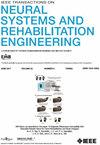N100和ASSR对意识障碍患者有何评价?
IF 4.8
2区 医学
Q2 ENGINEERING, BIOMEDICAL
IEEE Transactions on Neural Systems and Rehabilitation Engineering
Pub Date : 2025-04-23
DOI:10.1109/TNSRE.2025.3563593
引用次数: 0
摘要
目的:听觉诱发电位(AEP),特别是N100分量和听觉稳态反应(ASSR)已被应用于意识障碍(DOC)患者的临床评估。然而,这些措施的具体效用在研究中仍存在争议。方法:为了明确N100和ASSR在评估DOC患者听觉功能和意识水平中的作用,我们记录了30例DOC患者的N100和ASSR反应,并通过统计分析评估其在个体水平上的意义。结果:我们的研究结果表明,与N100相比,ASSR反应的重要性似乎是听觉功能更可靠的标志。然而,在反应和微状态水平上,N100和ASSR都不能有效区分被诊断为无反应性觉醒综合征(UWS)和最低意识状态(MCS)的患者。此外,我们在30名患者的独立队列中使用便携式脑电图设备验证了ASSR的作用。结论:总之,我们的研究结果表明,ASSR在评估DOC患者的听觉功能方面有希望,但其在区分意识水平方面的应用可能需要进一步考虑。意义:这些发现为临床医生和神经科学家选择和设计客观的DOC评估工具提供了有价值的见解。本文章由计算机程序翻译,如有差异,请以英文原文为准。
What Can N100 and ASSR Assess in Patients With Disorders of Consciousness?
Objective: Auditory Evoked Potentials (AEP), particularly the N100 component and the auditory steady-state response (ASSR), have been utilized in the clinical assessment of patients with Disorders of Consciousness (DOC). However, the specific utility of these measures remains debated across studies. Methods: To clarify the roles of N100 and ASSR in evaluating auditory function and levels of consciousness in DOC patients, we recorded N100 and ASSR responses in 30 DOC patients and assessed their significance at the individual level through statistical analyses. Results: Our findings indicate that, compared to N100, the significance of the ASSR response appears to be a more reliable marker of auditory function. However, neither N100 nor ASSR, at both response and microstate levels, could effectively distinguish between patients diagnosed with unresponsive wakefulness syndrome (UWS) and minimally conscious state (MCS). Additionally, we validated the role of ASSR using a portable EEG device in an independent cohort of 30 patients. Conclusion: In summary, our results suggest that ASSR holds promise for assessing auditory function in DOC patients, but its utility in differentiating levels of consciousness may require further consideration. Significance: These findings offer valuable insights for clinicians and neuroscientists in selecting and designing objective tools for DOC assessment.
求助全文
通过发布文献求助,成功后即可免费获取论文全文。
去求助
来源期刊
CiteScore
8.60
自引率
8.20%
发文量
479
审稿时长
6-12 weeks
期刊介绍:
Rehabilitative and neural aspects of biomedical engineering, including functional electrical stimulation, acoustic dynamics, human performance measurement and analysis, nerve stimulation, electromyography, motor control and stimulation; and hardware and software applications for rehabilitation engineering and assistive devices.

 求助内容:
求助内容: 应助结果提醒方式:
应助结果提醒方式:


